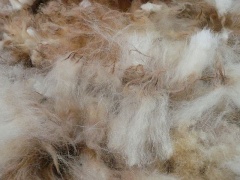Wool
From Cargo Handbook - the world's largest cargo transport guidelines website
| Infobox on Wool | |
|---|---|
| Example of Wool |  |
| Facts | |
| Origin |
|
| Stowage factor (in m3/t) |
|
| Humidity / moisture |
|
| Oil content | 10 - 20% (wool grease) |
| Ventilation | If the product is loaded for shipment in a dry state, it does not have any particular ventilation requirements. Problems arise if the product, packaging and/or ceiling/flooring are too damp; an air exchange rate of 10 changes/hour (airing) is then recommended. |
| Risk factors | Raw wool is an animal fiber. Wool is sensitive to unpleasant and pungent odors. Wool is particularly susceptible to mechanical damage, contamination and insect attack. Damp bales may also develop mildew due to mold and mildew stains due to bacteria. |











